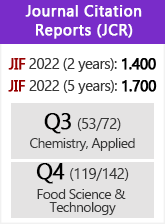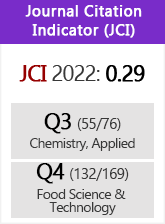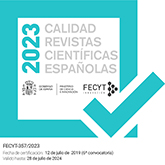Sensorial analysis and electronic aroma detection to compare olive oils produced by different extraction methods
DOI:
https://doi.org/10.3989/gya.010411Keywords:
Aroma, Electronic nose, Extraction technology, Olive oil, Sensorial analysisAbstract
A sensorial analysis and an aroma analysis by electronic sensory devices were used to compare olive oils produced according to two different extraction methods. The extraction methods compared were the press system and two phase decanter. Samples were taken from the harvests of 2002-2004 and the olives were all from the same variety. The variety used was the Portuguese Galega sp. Olives were picked and technologically handled under predetermined and supervised conditions. Olive oils produced were better classified when the sensory analysis by a panel was applied than when an electronic sensory analysis was performed, even after sensor optimization. This observation is in accordance with the fact that olive oil has a low volatility matrix and “flavor”, rather than aroma, can give a clearer characterization than electronic sensory analysis alone, where aroma is the main characteristic evaluated.
Downloads
References
Ardeshir, H. 1993 There’s no accounting for taste: or is there? Nutrition & Food Science 88, 10-12. http://dx.doi.org/10.1108/eb059173
Angerosa F, Servili M, Esposto S. 2004. Volatile compounds in virgin olive oil: occurrence and their relationship with quality. J. Chromatogr. A 1054, 17-31. PMid:15553127
Berna A. 2010. Metal Oxide Sensors for Electronic Noses and Their Application to Food Analysis. Sensor 10, 3882-3910. http://dx.doi.org/10.3390/s100403882
Blake AA. 2007. Flavour Perception and the Learning of Food Preferences, in A. J. Taylor and D. D. Roberts, editors Flavor Perception. Blackwell Publishing Ltd. Oxford, UK.
Brezmes J, Cabré P, Rojo S, Llobet E, Vilanova X, Correig X. 2007. Identificación de diferentes tipos de aceite de oliva mediante una nariz electrónica con sensores comerciales y algoritmos de procesado de señal. Available from: http://www.percepnet.com/tecno07_02.htm.
Cavalli JF, Fernandez X, Loiseau A. 2004. Characterization of volatile compounds of French and Spanish virgin olive oils by HS-SPME: identification of qualityfreshness markers. J. Agric. Food Chem. 88, 151-157.
Ferreira E, Rodrigues S, Ferreira M, Nóbrega J. 2002. Análise Exploratória dos Teores de Constituintes Inorgânicos em Sucos e Refrigerantes de Uva. Eclet Química 27, 77-90. http://dx.doi.org/10.1590/S0100-46702002000200007
García-González DL, Aparicio R. 2010. Coupling MOS sensors and gas chromatography to interpret the sensor responses to complex food aroma: Application to virgin olive oil. Food Chem. 120, 572-579. http://dx.doi.org/10.1016/j.foodchem.2009.09.097
Gracia MS, Royo A, Guillén M. 2009. Composición química de aceites de las variedades Arbequina y Empeltre cultivadas en regadio. Grasas Aceites 60, 321-329. http://dx.doi.org/10.3989/gya.097008
Gouveia JM. 1995. Azeites virgens do Alto Alentejo-Comportamentos químicos, tecnológico, e sensorial. (DPhil. Dissertation) PhD. UTL, ISA, Lisboa, Portugal 542 p.
International Olive Oil Council Resolutions. Madrid, 20 November 1996.
COI/T.20/Doc. no. 13/Rev.1. Sensory analysis of olive oil- Standard- General methodology for the organoleptic assessment of virgin olive oil.
COI/T.20/Doc. no. 15/Rev.1. Sensory analysis of olive oil-Method- Organoleptic assessment of virgin olive oil. RES-3/75-IV/96, Revised method for the organoleptic assessment of virgin olive oil.
COI/T.20/ Doc. no. 14/Rev.1. Sensory analysis of olive oil-Standard- Guide for the selection, training and monitoring of skilled virgin oil tasters. International Olive Oil Council Resolutions. Madrid, 18 June 1987 COI/T.20/Doc. no. 5. Sensory analysis of olive oil- Standard Glass for the oil tasting.
COI/T.20/Doc. no. 6. Sensory analysis of olive oil- Standard-Guide for the installation of a test room.
Kadiroglu P, Korel F, Tokatlı F. Classification of Turkish Extra Virgin Olive Oils by a SAW Detector Electronic Nose. J. Am. Oil Chem. Soc. (published on-line 5 Nov. 2010).
Lyon BG. 1987. Development of chicken flavour descriptive terms aided by multivariate statistical procedures. J. Sens. Stud. 2, 55–67 http://dx.doi.org/10.1111/j.1745-459X.1987.tb00186.x
Marques PA, Vaz-Freire L, Freitas AM. 2007. Comparação de alguns compostos do aroma de azeites obtidos por dois métodos de extracção diferentes. Rev Ciências Agrárias 183–186.
Morales MT, Luna G, Aparicio R. 2004. Comparative study of virgin olive oil sensory defects. Food Chem. 91, 293-301. http://dx.doi.org/10.1016/j.foodchem.2004.06.011
Morales MT, Luna G, Aparicio R. 2000. Sensory and chemical evaluation of winey-vinegary defect in virgin olive oils. Eur. Food Res. Technol . 211, 222-228. http://dx.doi.org/10.1007/s002170050028
Morales MT, Rios J, Aparicio R. 1997. Changes in the volatile composition of virgin olive oil during oxidation: flavours and off-flavours. J. Agri. Food Chem. 45, 2666-2673. http://dx.doi.org/10.1021/jf960585+
Moita Neto JM. 2004. Estatística Multivariada: uma visão didática- metodológica. Crítica - Revista de filosofia e ensino (serial on-line). Available from http://criticanarede.com/cien_estatistica.html. Posted 9th May 2004.
Poste LM, Willemon C, Butler G, Patterson C. 1986. Sensory Aroma Scores and TBA Values as Indices of Warmed-Over Flavour in Pork. J. Food Sci. 5, 886-888. http://dx.doi.org/10.1111/j.1365-2621.1986.tb11192.x
Regulation (EC) nº2568/1991 of Commission of 11 of July; Official Journal of Europeans Communities, L248, 5 September 1991.
Regulation (EC) nº1638/1992 of Commission of 29 of June; Official Journal of Europeans Communities, L176/27, 30 June 1992.
Regulation (EC) nº 1989/2003 of 6 November 2003 amending Regulation (EEC) No 2568/91 on the characteristics of olive oil and olive-pomace oil and on the relevant methods of analysis.
Ridolfi M, Patume M, Fontanazza G. 2002. Characterization of the lipoxygenases in some cultivars and determination of their role in volatile compounds formation. J. Agric. Food Chem. 50, 835-9. http://dx.doi.org/10.1021/jf0109118 PMid:11829653
Smith DV, Margolskee RF. 2001. Making Sense of Taste. Scient. American 284, 32-9.
Sousa A, Carvalho P. 2007. Utilização de Sensores no Ensino das Ciências. Departamento de Física, Faculdade de Ciências da Universidade do Porto. Available from: http://eec.dgidc.min.edu.pt/documentos/acompanhamento_porto_utilizacao_sensores.pdf
Vaz-Freire L. Gomes da Silva MDR, Costa Freitas AM. 2009. Comprehensive Two-Dimensional Gas Chromatography for Fingerprint Pattern Recognition in Olive Oils Produced by two Different Techniques in Portuguese Olive Varieties Galega Vulgar, Cobrançosa e Carrasquenha. Anal. Chim. Acta 633, 263-270. PMid:19166732
Vaz Freire L, Gouveia JM, Costa Freitas AM. 2008. Analytical characteristics of olive oils produced by two different extraction techniques, in the Portuguese olive variety Galega Vulgar. Grasas Aceites 59, 260-266.
Vekiari SA, Oreopoulou V, Kourkoutas Y, Kamoun N, Msallem, M, Psimouli V, Arapoglou D. 2010. Characterization and seasonal variation of the quality of virgin olive oil of the Throumbolia and Koroneiki varieties from Southern Greece. Grasas Aceites 61, 221-231. http://dx.doi.org/10.3989/gya.108709
Verrelli GM. 2008. Electronic Tongue systems for food and environmental applications. University of Rome Tor Vergata, Department of Electronic Engineering, Sensorial and Learning Systems Engineering XX Cycle. 210p.
Vichi S, Pizzale L, Conte LS, Buxaderas S, López-Tamames E. 2003. Solid-Phase Microextraction in the Analysis of Virgin Olive Oil Volatile Fraction: Modifications Induced by Oxidation and Suitable Markers of Oxidative Status. J. Agric. Food Chem. 51, 6564-6571. http://dx.doi.org/10.1021/jf030268k PMid:14558779
Downloads
Published
How to Cite
Issue
Section
License
Copyright (c) 2011 Consejo Superior de Investigaciones Científicas (CSIC)

This work is licensed under a Creative Commons Attribution 4.0 International License.
© CSIC. Manuscripts published in both the printed and online versions of this Journal are the property of Consejo Superior de Investigaciones Científicas, and quoting this source is a requirement for any partial or full reproduction.All contents of this electronic edition, except where otherwise noted, are distributed under a “Creative Commons Attribution 4.0 International” (CC BY 4.0) License. You may read here the basic information and the legal text of the license. The indication of the CC BY 4.0 License must be expressly stated in this way when necessary.
Self-archiving in repositories, personal webpages or similar, of any version other than the published by the Editor, is not allowed.
















